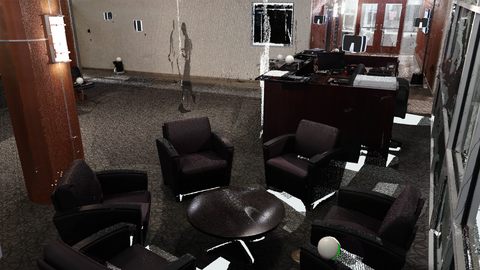DIGITAL TWINNING
Specializing in building digital twins, I create highly accurate 3D replicas of real-world environments for simulation, analysis, and optimization. Using LiDAR scanning, sensor data, and AI-driven modeling, I develop interactive and data-rich digital assets that enhance decision-making across industries. My work transforms physical spaces into dynamic virtual models for improved planning, training, and operational efficiency.

Transmission Electron Microscope Advanced VR Simulation
As the Project Manager, I spearheaded the development of an advanced virtual reality (VR) training simulation of a Transmission Electron Microscope (TEM) to support PhD students in Chemistry and Materials Science. Built in Unreal Engine and optimized for Meta Quest, the digital twin replicates the intricate environment and operational procedures of a real TEM, allowing students to safely learn and practice essential skills—from sample loading and beam alignment to image capture and troubleshooting.
This immersive training tool was designed to solve a key challenge in scientific education: the high cost and limited availability of sensitive lab equipment. By offering a photorealistic, fully interactive 3D simulation, the experience reduces wear on physical hardware while accelerating student learning through repetition, guided feedback, and scenario-based error correction.
-
Photorealistic 3D TEM model with accurate controls and behaviors
-
Interactive modules for setup, calibration, and operation
-
Built-in tutorials and AI-driven guidance system
-
Error simulation for troubleshooting practice
-
Multi-user capability for collaborative VR lab sessions
This project demonstrates how digital twins can revolutionize STEM training by combining accessibility, accuracy, and engagement in a fully immersive virtual environment.
LiDAR Scans
Front End Design
Training Simulation Game Play
C O M I N G S O O N

First Pentacostal Church of Denham Springs
As a R&D concept, I am currently designing a real-time digital twin of a 1,400-member mega church to streamline operations, improve resource management, and enhance member engagement through data-driven decision-making. Designed as a dynamic, web-accessible 3D environment, the digital twin integrates operational data, scheduling systems, and smart facility management to give administrators a clear, interactive view of daily activity and long-term trends.
This solution addresses the unique challenges of managing large, multifaceted church operations—automating tasks like event planning, volunteer coordination, space usage, and security monitoring. By visualizing processes in real time and applying predictive analytics, the digital twin helps leadership make faster, more informed decisions while creating a more personalized and efficient experience for congregants.
-
3D model of the full church campus with live event and usage data
-
Automated scheduling, volunteer tracking, and space allocation
-
Real-time occupancy and engagement analytics
-
Integration with donation platforms and facility systems
-
Scalable interface accessible via web browser or mobile devices
This theoretical project showcases how digital twins can transform community-driven organizations by combining operational clarity with technical innovation. ***Still in the design phase***
LiDAR Scans

NASA Michoud Assembly Facility
As part of a large team of research developers, I operaged as the Front End team lead to collaboratively developed a web-accessible digital twin interface for a NASA research team to support interactive decision-making, data visualization, and system simulation in real time. Built using Unreal Engine and pixel streaming technology, the project focused on creating a seamless connection between a complex 3D simulation environment and a browser-based user interface tailored to the needs of NASA engineers and administrators.
The system enables users to interact with mission-critical data and digital models through an intuitive, user-centered design—transforming how large datasets and simulations are understood and navigated. By translating backend complexity into an elegant, responsive experience, the digital twin empowers stakeholders to test scenarios, monitor performance, and collaborate remotely with ease.
-
Real-time Unreal Engine 3D environment streamed to any browser
-
Custom UI/UX design built around NASA workflow and data access needs
-
Interactive dashboards linked to backend simulation data
-
Support for multi-user collaboration and system monitoring
-
Designed for long-term scalability and mission adaptability
-
Implementation of Data Catalog and Digital Thread technology
-
Use of LLM and Ai Assistant
This project highlights the power of immersive technology and interface design to bridge advanced simulation with practical, high-stakes decision-making.
Front End | UI/UX Design

LSU Patrick Taylor Hall
As part of a collaborative graduate project, our team developed a digital twin of Patrick F. Taylor Hall—the largest academic engineering building in the United States—to assist LSU’s College of Engineering with space planning, student engagement, and strategic marketing. The immersive 3D environment was designed in Unreal Engine and integrated with live and simulated data to support real-time decision-making by college administrators.
The digital twin allows users to explore the building virtually, monitor space usage, and visualize foot traffic patterns, room occupancy, and departmental layouts. Designed with accessibility and scalability in mind, the tool serves as both a practical planning resource and an interactive showcase for prospective students, donors, and stakeholders.
-
Interactive 3D model of the entire engineering complex
-
Tools for space utilization, traffic flow analysis, and capacity planning
-
Web-accessible interface with pixel streaming for remote exploration
-
Modular backend to support future data integrations and smart campus features
-
Designed collaboratively by DMAE graduate students using Unreal Engine
This project demonstrates the potential of digital twins in higher education—combining spatial intelligence, administrative efficiency, and immersive storytelling in a single, intuitive platform.



































